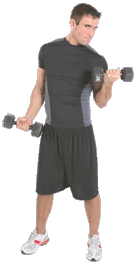At WiseGEEK, we're committed to delivering accurate, trustworthy information. Our expert-authored content is rigorously fact-checked and sourced from credible authorities. Discover how we uphold the highest standards in providing you with reliable knowledge.
What are Dragon Flags?
Dragon flags are intense abdominal exercises that also build upper body strength and balance. The name "dragon flag" was taken from "Little Dragon," a nickname of its creator, martial arts expert Bruce Lee. The exercise is considered extremely challenging and is recommended only for advanced workouts. Individuals must be in excellent physical condition to attempt the exercise.
Beginners are advised to consult a doctors and a trainer before attempting this exercise. Dragon flags have a high risk of injury for inexperienced individuals; a spotter should be on hand. The spotter can stand alongside the person attempting the dragon flag, near the chest area, and support his legs if he should lose his balance while performing the exercise.

The exercise is performed lying on one's back on an exercise bench. The arms are placed above the head, elbows bent, with the hands gripping the bench. The body is kept stiff to create a straight line from chest to toes. The body is then lifted up gradually until the toes are pointing to the ceiling, still tensed to create a rigid line from chest to toes.
The body's weight must never rest on the neck while performing dragon flags, as this can be dangerous. The abdominal muscles must be tightened to assist in maintaining balance. The exercise draws deeply on arm and core strength to be able to support the entire lower body's weight and balance.
After balancing upright, the body is then lowered in a controlled movement, until the buttocks are suspended above the bench. It is then lifted up again to repeat the exercise. Four to ten repetitions are sufficient per session, with two to five sessions a week recommended for serious bodybuilders. It is important that the exercise not be overdone or performed until exhaustion or failure, as this may result in serious injury.
Beginners may find it difficult to perform the exercise while keeping the entire body rigid. It is acceptable to bend the knees when learning dragon flags, to lessen the opposing force offered by the legs. In this case, the heels are tucked against the buttocks at the starting position before the body is lifted into the air. The hips must still not bend at any time.
Experienced individuals who have mastered the straight-legged dragon flags may advance to a more challenging version. One-armed dragon flags are performed in the same manner, but with little to no assistance from one arm. When learning this version, a sturdy rope is stretched taut behind the exercise bench, and one hand grips the rope; the lower the position of the hand on the rope, the less leverage exerted by the hand. Gradually, the body will grow used to performing the exercise with support from just one arm. It is recommended that the user interchange arms when performing this exercise, so that the muscle strength in both arms may remain balanced.
AS FEATURED ON:
AS FEATURED ON:










Discuss this Article
Post your comments